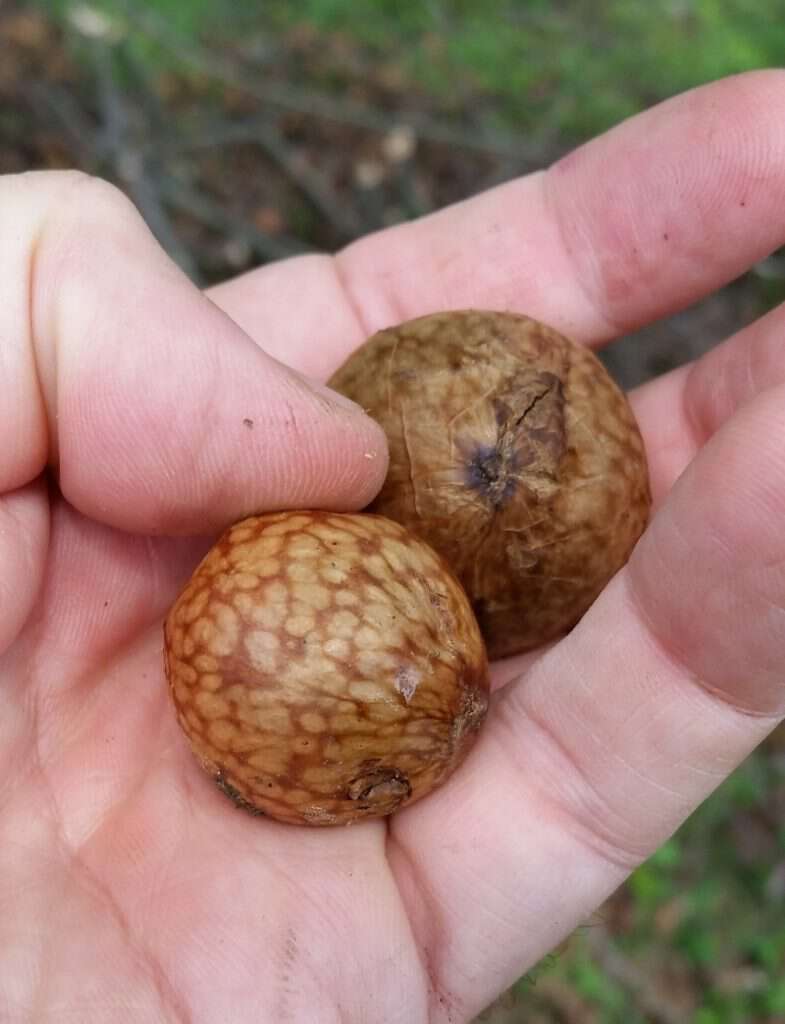
I recently received the photos in this post and the email below from Blind Pig reader DS.
————–
Tipper – Great blog I enjoy reading!
But I have a question you or your readers may be able to answer. Attached are photos of a fruit(?) I’ve been finding in the backyard under oak trees. There are also a maple, hickory, redbud, dogwood, persimmon and even an old pear tree – so I’m not certain where it originated. Even more surprised when I cut one open! I’ve noticed a few of these on and off for years.
Thanks! DS

————–
My first thought was that the fruit looked like a plum, but I actually have no clue. If you know what the fruit is please leave a comment and help DS out.
**UPDATE: It’s 8:30 a.m. and folks are already sending me the answer to the question. Jim Casada commented it was an oak gall and Ray Algee agreed and sent me a link about oak gall. Go here to see it.
Tipper

Tipper,
Leave it to the old (I am saying “old Jim” in jest) Jim the Woodsman to be the first to get “Oak Apple” correct! Right on Jim!
Missed this post yesterday!
There must be a lot of those pesky waspers (name starts with a C, but eludes me right now) around and about DS’s oak trees to have that many galls falling.
I am going to hunt me some and give making the ink a try!
Thanks Tipper,
PS…I have the “gall” to think I can make it like my ancestors! ha
Yes, it’s an oak gall.
I’ve seen these in my younger days wondering around in the woods or Squirrel hunting.. Never knew what they were, now I know..
I’ve been saving oak galls to make a dyepot for yarn (similar to the ink-making use folks have mentioned), but I collect the galls that are already empty and papery-thin, having been vacated by the bug.
Hi Tipper,
I’m a Master Gardener in Marion County, Florida, and following is some of the information we provide to our clients:
A gall is a growth of plant tissue that starts with an organism’s (insects, mites, fungi) chemical and/or mechanical stimulus, which increases the plant’s production of plant growth hormones.
Galls are made of cells that are more numerous or larger than normal plant cells, or plant organs whose growth and development have been altered into unusual shapes.
An insect gall forms because of the plant’s response to the insect’s egg laying, presence of the egg, and/or feeding stimulation by the larva. Plant cells are usually modified and enlarged, the plant tissue surrounds the egg or larva, and the gall protects and feeds the gall-maker.
Tipper,
I use to squirrel hunt where there was lots of White Oaks, Red Oaks, Chestnut Oaks, and so forth, probably stepped on some of these little things along the way. But mostly I got in alot of Hickory Trees cause I could hear them cutting and see all the evidence on the ground. Never paid much attention to the White Oak galls laying around. Interesting stuff!…Ken
I have seen lots of oak galls before but don’t remember examining one closely. I thought they were hollow inside with a papery shell.
I think Jim is right on, the Gall can be caused by insects and at a certain age the Gall will contain a visable larvae, after the larvae hatches the Gall will eventually dry out and be almost hollow with a thin almost paper like skin. At times in history the tannin from the Galls have been mixed with iron salts to create an ink. There are many types of Galls pictured on Google, a couple look just like the ones in this blog.
I agree with Jim. We called them “ink balls”. They seem to always be associated with oak trees. Don’ t believe eating them would be a good idea.
It does look like a plum
I agree, it is an oak gall. We have them in here in Oregon also.
I agree, it is an oak gall. We have them in here in Oregon also.
I agree, it is an oak gall. We have them in here in Oregon also.
I agree, it is an oak gall. We have them in here in Oregon also.
Yes, it is an oak gall and it is caused by an insect. My Grandma told me the old timers made an ink out of them but I do not recall her saying what they used for the liquid. One possibility might be whiskey. I don’t think vinegar would have worked.
Tipper,
I believe Jim is right on track. I’ve found a few under some big white oaks at church.
If I remember correctly from my research they caused by some type of wasp.
Looks like a gooseberry.
Tipper–I’m fairly certain it’s an oak gall. It’s caused by some type of insect.
Jim Casada
Is it edible? Very interesting, don’t think I’ve seen that fruit/seed before.